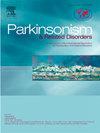Does duration Matter? Evaluating the impact of short- and long-term telemedicine in functional motor disorders
IF 3.1
3区 医学
Q2 CLINICAL NEUROLOGY
引用次数: 0
Abstract
Introduction
Functional motor disorders (FMDs) are chronic neurological conditions characterized by altered expectations, disrupted attention, and a sense of agency, requiring long-term management. While 12-week telemedicine programs have shown effectiveness, the optimal duration for sustaining benefits remains unclear. We therefore aim to compare the effects of an extended 24-week telemedicine program with a standard 12-week program in managing FMDs.
Methods
52 consecutive patients with FMDs completed a five-day intensive, multidisciplinary rehabilitation program followed by a standard 12-week telemedicine program. Participants were then allocated consecutively to either a self-management program without telemedicine support (control group, CG, n = 26) or an extended 24-week telemedicine program with biweekly sessions (experimental group, EG, n = 26). Motor and non-motor symptoms, Quality of Life (QoL), and self-perception of change were assessed at baseline (T0), after 12 weeks (T1), and 36 weeks (T2).
Results
Significant time effects were found for all outcomes except the Mental Health QoL. Significant Time × Group interaction was observed for TAS-20 (p < 0.001), where the CG reported a reduction both at T1 (p = 0.003) and T2 (p < 0.001), not observed in the EG. The CG reported a significant worsening in their self-perception of improvement at nine months (T2) compared to the EG (p = 0.015).
Conclusions
Extending the telemedicine program, even at a reduced biweekly frequency, may help sustain perceived improvements despite the absence of additional motor benefits. Such disconnection might be related to the strong role of altered expectations and attention within this disorder.
持续时间重要吗?评估短期和长期远程医疗对功能性运动障碍的影响
功能性运动障碍(fmd)是一种慢性神经系统疾病,其特征是期望改变、注意力中断和代理感缺失,需要长期治疗。虽然12周的远程医疗项目已经显示出效果,但维持效益的最佳持续时间仍不清楚。因此,我们的目标是比较延长的24周远程医疗计划与标准的12周计划在管理口蹄疫方面的效果。方法连续52例fmd患者完成了为期5天的多学科强化康复计划,随后进行了标准的12周远程医疗计划。然后,参与者被连续分配到没有远程医疗支持的自我管理计划(对照组,CG, n = 26)或延长24周的远程医疗计划,每两周一次(实验组,EG, n = 26)。在基线(T0)、12周(T1)和36周(T2)时评估运动和非运动症状、生活质量(QoL)和自我感知变化。结果除心理健康生活质量外,其他指标均存在显著的时间效应。TAS-20的时间与组间相互作用显著(p <;0.001),其中CG在T1 (p = 0.003)和T2 (p <;0.001),在EG中未观察到。与EG组相比,CG组在9个月(T2)时的自我改善感知显著恶化(p = 0.015)。结论延长远程医疗计划,即使减少两周一次的频率,也可能有助于维持感知到的改善,尽管没有额外的运动益处。这种脱节可能与这种疾病中改变的期望和注意力的强大作用有关。
本文章由计算机程序翻译,如有差异,请以英文原文为准。
求助全文
约1分钟内获得全文
求助全文
来源期刊

Parkinsonism & related disorders
医学-临床神经学
CiteScore
6.20
自引率
4.90%
发文量
292
审稿时长
39 days
期刊介绍:
Parkinsonism & Related Disorders publishes the results of basic and clinical research contributing to the understanding, diagnosis and treatment of all neurodegenerative syndromes in which Parkinsonism, Essential Tremor or related movement disorders may be a feature. Regular features will include: Review Articles, Point of View articles, Full-length Articles, Short Communications, Case Reports and Letter to the Editor.
 求助内容:
求助内容: 应助结果提醒方式:
应助结果提醒方式:


